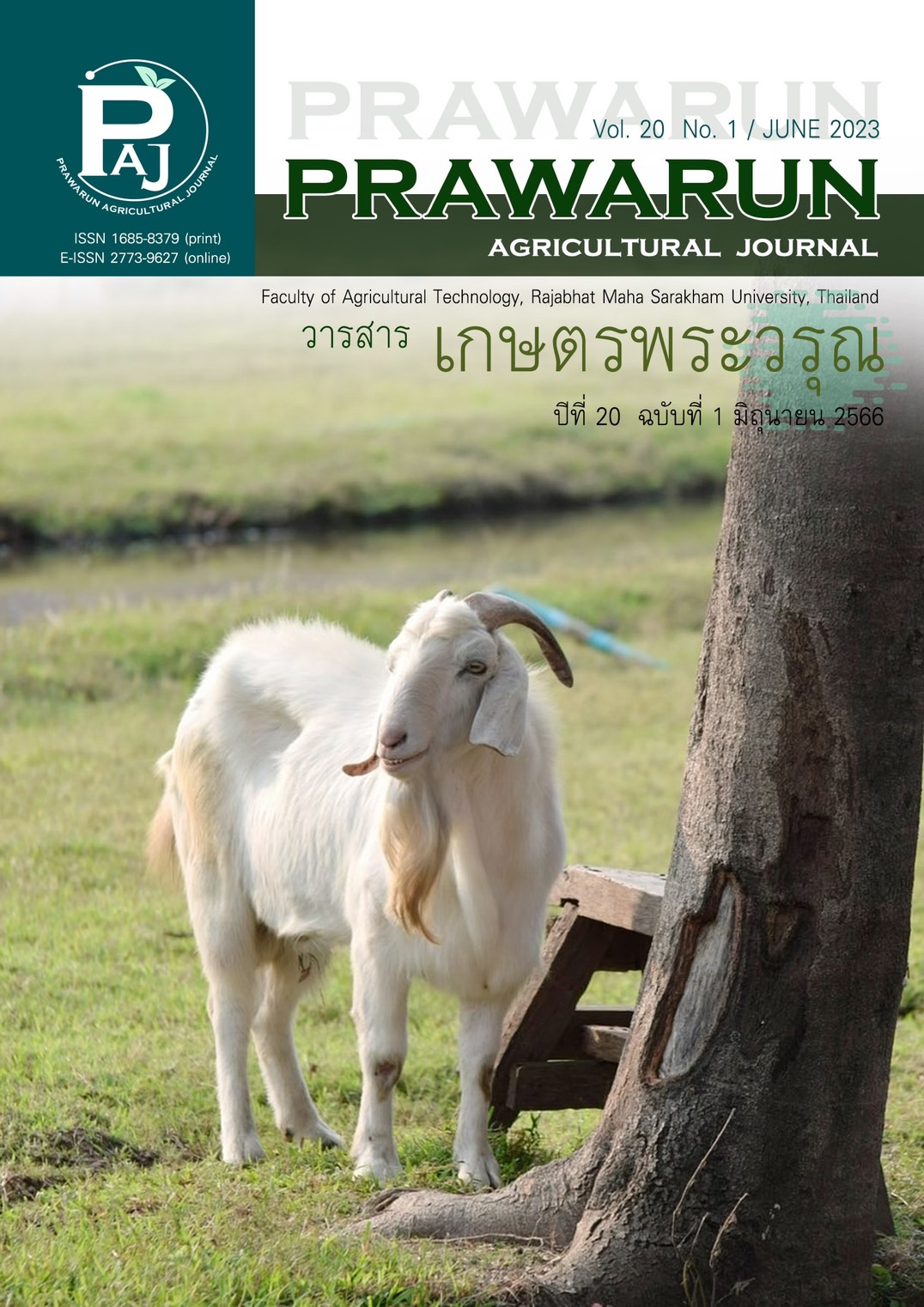The prediction Brahman X Charolais and Brahman X Thai native with Evolutionary-Extreme Learning Machine in Phetchabun Province Thailand.
Main Article Content
บทคัดย่อ
The purpose of this study was to develop a growth forecasting model for Stocker Cattle Producers. In the long yearling (12-24 months) breed, only Brahman X Charolais and Brahman X Thai native were selected, all of which are 50 % breed (F1) from 17 Sub-Districts in Muang District, Phetchabun, Thailand. There were three different forecasting model methods: 1) Extreme Learning Machine (ELM); 2) Weighted- Extreme Learning Machine (Weighted ELM) and 3) Evolutionary- Extreme Learning Machine (ELM). The surveyed data were taken through the Feature Selection process to select factors affecting the relationship between feed intake, along with the growth rate according to body weight during the month. The recording data was then used to create a forecasting model to create an estimate of the weight of beef cattle that is close to the best growth. The results indicated that Evolutionary-ELM was able to gain weight during the 19th months on an average of up to 500 kilograms after the cattle were fed continuously until the 24th months. The prognostic results of Brahman X Charolais beef cattle could be predicted as an average weight of 604.088 kilograms an error at R2=0.9327, with growth rate Y=30.562x-129.40, RMSE=0.130, MSE=0.107. Brahman X Thai native beef cattle could be predicted for 509.982 kilograms an error at R2=0.9706, with growth rate Y=28.098x-164.37, RMSE=0.117, MSE=0.083. The Evolutionary-ELM algorithm learns and adjusts the weights to optimize the best results for each month's growth period, which reduces the problem of margin, keeping the distance not too high or too low. It can be used as a model for raising large beef cattle weighing 550-650 kilograms, allowing farmers who are interested in beef cattle farming to compare the model with their decision-making.
Article Details
เอกสารอ้างอิง
Bartlet, P. L. (1996). The sample complexity of pattern classification with neural networks: the size of the weights is more important than the size of the network. IEEE Transactions on Information Theory, 44(2), 525-536.
Boonprong, S., Choothesa, A., Sribhen, C., Parvizi, N., & Vajrabukka, C. (2008). Productivity of Thai Brahman and Simmental-Brahman crossbred (Kabinburi) cattle in central Thailand. International Journal of Biometeorology, 52(5), 409-415. doi: 10.1007/s00484-007-0135-2
Boyce, C., & Neale, P. (2006). Conducting in-depth interviews: A guide for designing and conducting in-depth interviews for evaluation input (Vol. 2). Massachusetts: Pathfinder International.
Bunmee, T., Chaiwang, N., Kaewkot, C., & Jaturasitha, S. (2018). Current situation and future prospects for beef production in Thailand—A review. Asian-Australasian Journal of Animal Sciences,31(7), 968-975. doi: 10.5713/ajas.18.0201
Ghosh, R., & Verma, B. (2003). A hierarchical method for finding optimal architecture and weights using evolutionary least square based learning. International Journal of Neural Systems, 13(1), 13-24. doi.org/10.1142/S0129065703001364
Huang, G. B, & Babri, H. A. (1998). Upper bounds on the number of hidden neurons in feedforward networks with arbitrary bounded nonlinear activation functions. IEEE Transactions on Neural Networks, 9(1), 224-229. doi: 10.1109/72.655045
Huang, G. B., Zhu, Q. Y., & Siew, C. K. (2006). Extreme learning machine: Theory and applications. Neurocomputing, 70(1-3), 489-501.
Khunchaikarn, S., Mankeb, P., & Suwanmaneepong, S. (2022). Economic efficiency of beef cattleproduction in Thailand. Journal of Management Information and Decision Sciences, 25(2). 1-9.
Krasachat, W. (2008). Livestock production systems and technical inefficiency of feedlot cattle farms in Thailand. Chulalongkorn Journal of Economics, 20(2). 141-154.
Labani, M., Moradi, P., Ahmadizar, F., & Jalili, M. (2018). A novel multivariate filter method for feature selection in text classification problems. Engineering Applications of Artificial Intelligence, 70, 25-37. doi: 10.1016/j.engappai.2017.12.014
Lee, D. H., Lee, S. H., Cho, B. K., Wakholi, C., Seo, Y. W., Cho, S. H., Kang, T. H., & Lee W. H. (2020). Estimation of carcass weight of Hanwoo (Korean native cattle) as a function of body measurements using statistical models and a neural network. Asian-Australasian Journal of Animal Sciences, 33(10), 1633-1641. doi: 10.5713/ajas.19.0748
Na-Chiangmai, A. (2002) Current situation and development trends of beef production in Thailand. In Allen, J., & Na-Chiangmai, A. (Eds), Development strategies for genetic evaluation for beef production in developing countries (pp. 93-97). Canberra: Australian Centre for International Agricultural Research.
Ogino, A., Sommart, K., Subepang, S., Mitsumori, M., Hayashi, K., Yamashita, T. & Tanaka, Y. (2016).Environmental impacts of extensive and intensive beef production systems in Thailand evaluatedby life cycle assessment. Journal of Cleaner Production, 112(Part 1), 22-31.
Osothongs, M., Khemsawat, J., Sarakul, M., Jattawa, D., Suwanasopee, T., & Koonawootrittriron, S. (2016). Current situation of beef industry in Thailand. Proceedings of International Symposium:“Dairy cattle beef up beef industry in Asia: Improving productivity and environmental sustainability (pp. 5-8). Bangkok: Swissotel Le Concorde.
Pilajun, R., Thummasaeng, K., Sawasdiphan, S., Suwanlee, S., Inthisaeng, W., & Wanapat, M. (2019). Growth performance of Lowline Angus x Thai native crossbred beef under tropical condition. Tropical Animal Health and Production, 51(8), 2253-2261. doi: 10.1007/s11250-019-01940-z
Senarath, S., Thummasaeng, K., & Suriyapat, W. (2009). Protein requirement for maintenance of yearling Thai native cattle. JIRCAS Working Report, 64, 83-85.
Steinfeld, H., Wassenaar, T., & Jutzi, S. (2006). Livestock production systems in developing countries: Status, drivers, trends. International Office of Epizootics, 25(2), 505-516.
Storn, R., & Price, K. (1997). Differential evolution-A simple and efficient heuristic for global optimization over continuous spaces. Journal of Global Optimization, 11(4), 341-359.
Thapa, G. B., Lam-Estrada, P., & Lopez-Bonilla, J. (2018). On the Moore-Penrose generalized inverse matrix. World Scientific News, 95, 100-110.
Zhu, Q. Y., Qin, A. K., Suganthan, P. N., & Huang, G. B. (2005). Evolutionary extreme learning machine. Pattern Recognition, 38(10), 1759-1763. doi: 10.1016/j.patcog.2005.03.028.
Zong, W., Huang, G. B., & Chen, Y. (2013). Weighted extreme learning machine for imbalance learning. Neurocomputing, 101(1-3), 229-242. doi: 10.1016/j.neucom.2012.08.01


